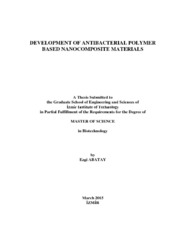Please use this identifier to cite or link to this item:
https://hdl.handle.net/11147/4442Full metadata record
| DC Field | Value | Language |
|---|---|---|
| dc.contributor.advisor | Arslanoğlu, Alper | - |
| dc.contributor.advisor | Tanoğlu, Metin | - |
| dc.contributor.author | Abatay, Ezgi | - |
| dc.date.accessioned | 2015-12-28T13:57:02Z | - |
| dc.date.available | 2015-12-28T13:57:02Z | - |
| dc.date.issued | 2015-03 | - |
| dc.identifier.citation | Abatay, E. (2015). Development of antibacterial polymer based nanocomposite materials. Unpublished master's thesis, İzmir Institute of Technology, İzmir, Turkey | en_US |
| dc.identifier.uri | http://hdl.handle.net/11147/4442 | - |
| dc.description | Thesis (Master)--Izmir Institute of Technology, Biotechnology, Izmir, 2015 | en_US |
| dc.description | Full text release delayed at author's request until 2018.04.15 | en_US |
| dc.description | Includes bibliographical references (leaves: 82-85) | en_US |
| dc.description | Text in English; Abstract: Turkish and English | en_US |
| dc.description | xv, 85 leaves | en_US |
| dc.description.abstract | Human beings are often infected by microorganisms such as bacterium, mold, yeast, virus, etc. in the living environment. It became a requirement and a necessity to create sterile fields in areas. Composite stones are one of the main materials that can be used for the contact surfaces in indoor and outdoor places due to their being of highly resistant to abrasives, chemicals and impacts. Research has been intensive in antibacterial material containing various inorganic substances. The aim of this thesis is investigating the antibacterial effect of inorganic substances such as silver, zinc oxide, calcium oxide, titanium oxide and magnesium oxide on stone products. This study also deals with the silver doped zinc oxide powder and their antibacterial efficacies. Stone product is formed of mainly two type compound which are quartz aggregates as reinforced and filler and thermoset polyester resin as matrix. The manufacturing process begins with selection of raw quartz materials. They are crushed and blended in the ratio of 90 % quartz aggregates to 10% polyester matrix and other additives such as antibacterial agent, pigment. These united constituents are used for production of composite stones by applying those combined vacuum, vibration and pressing processes which are named as vibropress, simultaneously. Following it, they are subjected to surface preparation and polishing processes. In this study, mechanical, thermal, and morphological properties of the particles, polyester matrix and stone product were investigated. Antibacterial efficacies of these were investigated based on colony-count method against gram negative (E.coli) and gram positive (Bacillus subtilis) bacteria. Silver-containing stone samples showed best antibacterial property about ninety-nine percent reduction. | en_US |
| dc.description.tableofcontents | İnsanlar bakteri, küf, maya, virüs gibi mikroorganizmalar tarafından sıklıkla enfekte edilir. Bu yüzden steril alanları oluşturmak zorunluluk ve gereklilik haline gelmiştir. Kompozit taşlar; aşındırıcılar, kimyasallar ve darbelere karşı son derece dayanıklı olmaları nedeni ile kapalı ve açık mekanlarda temas eden yüzeylerde kullanılabilen ana malzemelerden biridir. Araştırmalar çeşitli inorganik maddeler içeren antibakteriyel malzemeler üzerine yoğunlaşmıştır. Bu tezin amacı, taş üzerindeki gümüş, çinko oksit, kalsiyum oksit, titanyum oksit ve magnezyum oksit gibi inorganik maddelerin antibakteriyel etkisini araştırmaktır. Bu çalışma aynı zamanda gümüş katkılı çinko oksit tozu ve antibakteriyel etkinlikleri ile ilgilenir. Kompoze taş, matris olarak ısıyla sertleşen poliester reçine dolgu ve takviye amaçlı olarak kuvars agregalardan oluşan başlıca iki tip bileşenden oluşturulur. Üretim süreci ham kuvars malzemelerinin seçimi ile başlar. % 10 poliester resin, antibakteriyel ajan, ve pigment gibi katkı maddeleri, kuvars agregaları ile % 90 oranında karıştırılır. Bu birleşik bileşenler, vibropres olarak adlandırılan presleme işlemi, birleşik vakum, presleme ve titreşim aynı zamanda uygulanarak kompozit taşların üretimi için kullanılmaktadır. Bunu takiben, bu taşlar yüzey hazırlama ve parlatma süreçlerine tabi tutulur. Bu çalışmada, partiküllerin, polyester matrisin ve üretilen taşın morfolojik, termal ve mekanik özellikleri incelenmiştir. Bunların antibakteriyel etkinlikleri gram negatif (E. coli) ve gram pozitif (Bacillus subtilis) bakterilerine karşı koloni sayım yöntemi baz alınarak incelenmiştir. Gümüş içeren taş örnekleri yaklaşık yüzde doksan dokuz bakteriyel azalma ile en iyi antibakteriyel özelliği göstermiştir. | en_US |
| dc.language.iso | en | en_US |
| dc.publisher | Izmir Institute of Technology | en_US |
| dc.rights | info:eu-repo/semantics/openAccess | en_US |
| dc.subject | Nanocomposites | en_US |
| dc.subject | Antibacterial agents | en_US |
| dc.subject | Polymers | en_US |
| dc.title | Development of Antibacterial Polymer Based Nanocomposite Materials | en_US |
| dc.title.alternative | Antibakteriyel Polimer Esaslı Nanokompozit Malzemelerin Geliştirilmesi | en_US |
| dc.type | Master Thesis | en_US |
| dc.institutionauthor | Abatay, Ezgi | - |
| dc.department | Thesis (Master)--İzmir Institute of Technology, Bioengineering | en_US |
| dc.relation.publicationcategory | Tez | en_US |
| dc.identifier.wosquality | N/A | - |
| dc.identifier.scopusquality | N/A | - |
| item.grantfulltext | open | - |
| item.fulltext | With Fulltext | - |
| item.languageiso639-1 | en | - |
| item.openairetype | Master Thesis | - |
| item.cerifentitytype | Publications | - |
| item.openairecristype | http://purl.org/coar/resource_type/c_18cf | - |
| Appears in Collections: | Master Degree / Yüksek Lisans Tezleri Sürdürülebilir Yeşil Kampüs Koleksiyonu / Sustainable Green Campus Collection | |
Files in This Item:
| File | Description | Size | Format | |
|---|---|---|---|---|
| T001373.pdf | MasterThesis | 4.09 MB | Adobe PDF |  View/Open |
CORE Recommender
Page view(s)
430
checked on Jun 10, 2025
Download(s)
220
checked on Jun 10, 2025
Google ScholarTM
Check
Items in GCRIS Repository are protected by copyright, with all rights reserved, unless otherwise indicated.